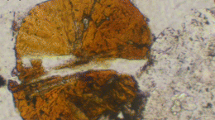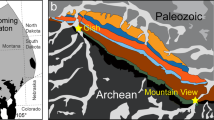Abstract
From 2 to 28% opal-cristobalite was isolated from the 2–20 µm fraction of rhyolitic and andesitic tuffaceous pyroclastics from the Island of Honshu, Japan, where it had been formed in hydrothermal springs at temperatures of ∼25–170°C as calculated from the oxygen isotopic ratios (18O/16O). Three of the isolates gave X-ray powder diffractograms with strong peaks at 4.07 Å. Two of these also had very weak peaks at 4.32 Å indicative of the presence of traces of tridymite. The fourth isolate had a strong 4.11 Å cristobalite peak and a very weak 4.32 Å peak. The morphology, determined by the scanning electron microscope, varied with the formation temperature indicated by the oxygen isotopic ratio (δ18O), from spheroidal and spongy for the opal-cristobalite formed at t}25°C (δ18O = 26.0‰) in contrast to angular irregular plates and prisms for that formed at ∼115°C (11.9‰), ∼135°C (7.9 ‰) and ∼170°C (6.8 ‰). The differences in δ18O values are attributed to variation in hydrothermal temperature, but some variability in oxygen isotopic composition of the water is possible. The field-measured temperatures related roughly with the calculated fractionation temperatures except in one site, while the contrast in cristobalite morphology related well to calculated low and high fractionation temperatures. Low-cristobalite of hydrothermal origin in New Zealand (δ18O = 9‰) had characteristic rounded grains with some evidence of platiness. Co-existing quartz grains (δ18O = 10‰) showed more subhedral and irregular prismatic morphology.
Similar content being viewed by others
References
Clayton, R. N. and Mayeda, T. (1963) The use of bromine pentafluoride in the extraction of oxygen from oxides and silicates for isotopic analysis: Geochim. Cosmochim. Acta 27, 43–52.
Clayton, R. N., O’Neil, J. R. and Mayeda, T. K. (1972) Oxygen isotope exchange between quartz and water: J. Geophys. Res. 77, 3057–3067.
Degens, E. T. and Epstein, S. (1962) Relation between O18/O16 ratios in coexisting carbonates, cherts and diatomites: Bull. Am. Assoc. Petrol. Geol. 46, 534–542.
Francis, C. W., Tamura, T., Bonner, W. P. and Amburgey, J. W., Jr. (1970) Separation of clay minerals using iso-pycnic zonal centrifugation: Soil Sci. Soc. Am. Proc. 34, 351–353.
Fujii, N., Oyagi, N., Takeshi, H., Koizumi, H. and Okubo, T. (1966) Geologic occurrence and some mineralogical and physical properties of altered rocks at Ōwakudani, Mt. Hakone, Japan: Rep. Coop. Res. Disaster Prevention 7, 7–18 (in Japanese).
Henderson, J. H., Jackson, M. L., Syers, J. K., Clayton, R. N. and Rex, R. W. (1971) Cristobalite authigenic origin in relation to montmorillonite and quartz origin in bentonites: Clays & Clay Minerals 19, 229–238.
Henderson, J. H., Clayton, R. N., Jackson, M. L., Syers, J. K., Rex, R. W., Brown, J. L. and Sachs, I. B. (1972) Cristobalite and quartz isolation from soils and sediments by hydrofluosilicic acid treatment and heavy liquid separation: Soil Sci. Soc. Am. Proc. 36, 830–835.
Matsubaya, O., Sakai, H., Kusachi, I. and Satake, H. (1973) Hydrogen and oxygen isotopic ratios and major element chemistry of Japanese thermal water systems: Geochem. J. 7, 123–151.
Murata, K. J. and Nakata, J. K. (1974) Cristobalitic stage in the diagenesis of diatomaceous shale: Science 184, 567–568.
Oehler, J. H. (1973) Tridymite-like crystals in cristobalitic “cherts”: Nature 241, 64–65.
Sayin, M. and Jackson, M. L. (1975) Scanning electron microscopy of cherts in relation to the oxygen isotopic variation of soil quartz: Clays & Clay Minerals 23, 365–368.
Sridhar, K., Jackson, M. L. and Clayton, R. N. (1975) Quartz oxygen isotopic stability in relation to isolation from sediments and diversity of source: Soil Sci. Soc. Am. Proc. 39, 1209–1213.
Swindale, L. D. and Jackson, M. L. (1956) Genetic processes in some residual podzolized soils of New Zealand: Int. Congr. Soil Sci., 6th Trans Congr. (Paris) 5, 233–239.
Takahashi, K., Itoh, S. and Maeda, K. (1966) Geochemical investigation of the fumarolic gases at Owakudani, Hakone Volcano: Rep. Coop. Res. Disaster Prevention 8, 13–19.
Takeshi, H., Fujii, N. and Fujinuki, T. (1969) Transformation of montmorillonites in acid clay deposits by weathering: Proc. Intern. Clay Conf. (Tokyo) 1, 369–382; 2, 99–101.
Taylor, H. P. (1968) The oxygen isotope geochemistry of igneous rocks: Contr. Mineral. Petrol. 10, 1–71.
Weaver, F. M. and Wise, S. W. (1972) Ultramorphology of deep sea cristobalitic chert: Nature 237, 56–57.
Author information
Authors and Affiliations
Rights and permissions
About this article
Cite this article
Jackson, M.L., Clayton, R.N., Fujii, N. et al. Cristobalite Morphology and Oxygen Isotopic Composition Variation under Hydrothermal Alteration. Clays Clay Miner. 25, 31–38 (1977). https://doi.org/10.1346/CCMN.1977.0250106
Received:
Published:
Issue Date:
DOI: https://doi.org/10.1346/CCMN.1977.0250106




